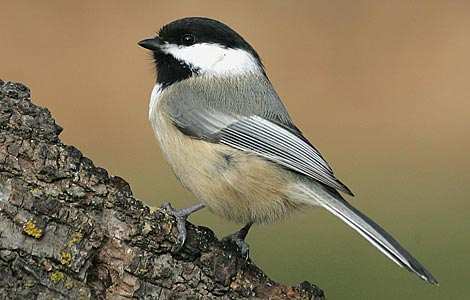Black-capped Chickadee - Poecile atricapilla

Description: 4 3/4-5 3/4" (12-15 cm). Black cap and throat, white cheeks, gray back, dull white underparts. Wing feathers narrowly and indistinctly edged with white.
Habitat: Deciduous and mixed forests and open woodlands; suburban areas in winter.
Nesting: 6-8 brown-speckled white eggs in a cup of grass, fur, plant down, feathers, and moss, placed in a hole in a rotten tree stub excavated by the birds, or in a natural cavity or bird box.
Range: Largely resident from Alaska east across Canada to Newfoundland, south to northern California, northern New Mexico, Missouri, and northern New Jersey. Winters south to Maryland and Texas.
Voice: A buzzy chick-a-dee-dee-dee or a clear, whistled fee-bee, the second note lower and often doubled.
Discussion: These birds are constantly active -- hopping, often feeding upside down, clinging to the underside of twigs and branches in their search for insect eggs and larvae. Flocks of this tame and inquisitive bird spend the winter making the rounds of feeders in a neighborhood, often appearing at each feeder with striking regularity. Chickadees form the nucleus of mixed flocks of woodpeckers, nuthatches, creepers, and kinglets that move through the winter woods. In spring, chickadees disband into the woods to nest. Black-capped Chickadees usually prepare their own nesting hole in soft, rotting tree stumps. Enticing them into breeding boxes is difficult unless the boxes are filled with sawdust, which deceives the chickadees; they carry the sawdust out bit by bit and accept the box for nesting.